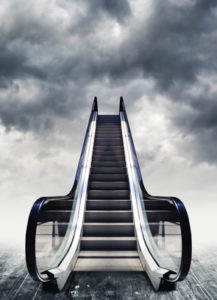Preventing the Relapse Process, Part 2

Recovery can be likened to walking up a down escalator. Imagine an escalator that stretches so far up that it disappears in the distance. As every child knows the trick to walking up one is to climb faster than the escalator is pulling you back. You could climb so far up this imaginary escalator, that you would no longer see the bottom. But the moment your climbing effort is less than the downward pull of the escalator, you begin moving back towards that bottom. That’s what relapse is like.
You might even be objectively climbing up the escalator, but if it isn’t enough to counter the downward pull, you have only delayed the inevitable. You have to be climbing as least as fast as the escalator is pulling you back to not lose ground. And that is what relapse prevention is like.
Relapse is a process, not an event. The last thing that happens in a relapse process is resuming alcohol or drug use. Depending on the effort you made to progress up the escalator of recovery, your relapse process could take a long time to play out. I’ve known people who identified patterns of relapse that stretched over years of their abstinent lives before they resumed active drinking or drugging. Perversely, this can be a message of hope and not hopelessness. If your relapse process takes months or years to lead you back to active drinking or drug use, then you have months or even years to recognize the problem and prevent it from getting any worse.
In the first part of this article we looked at coping with problems or stuck points in recovery and the high risk factors and trigger events that increase the likelihood of relapse if they are handled incorrectly. This discussion on relapse applies the thinking of Terence Gorski on relapse and relapse prevention, particularly his use of the Relapse/Recovery Grid in Passages Through Recovery and the booklet, The Relapse/Recovery Grid. There are also several articles using this material available on his blog, Terry Gorski’s Blog, including: “Understanding Relapse and Relapse Prevention.”
“The general direction towards relapse is from denial and evasion to high-risk lifestyle factors.” We left off a discussion of the relapse process in Part 1 with a description of high-risk situations and trigger events. High-risk factors make you vulnerable to trigger events, which can be “anything that causes sudden stress, pain, or discomfort.” They can be internal or external triggers. The interaction of high-risk situations and trigger events determines how the Relapse Process advances.
When there are relatively few high-risk factors in a person’s life, it will take a greater stressor to trigger the internal dysfunction of relapse. Conversely, with more high-risk factors, even a minor event can trigger internal dysfunction. “As internal dysfunction increases, the ability to manage reality gets worse, and more problems develop.” This internal dysfunction in early recovery is post acute withdrawal (PAW). See “Recognize Your PAWS” and “Manage Your PAWS.” Or you can read Gorski’s Comprehensive Guide to PAW here.
Internal Dysfunction
When under high stress, many recovering people begin to have difficulty thinking clearly, managing feelings and emotions, and remembering things. One of the main culprits leading to these problems appears to be a tendency to overreact to stressors. . . . Eventually the ability to sleep restfully is disrupted. This heightens stress and fatigue to the point where people become accident-prone.
Thinking problems can range from difficulty concentrating or thinking logically, to racing, repetitive thoughts. The person isn’t always clear about how things affect or relate to each other. “They have difficulty deciding what to do next to manage their lives and recovery.”
Feelings and emotions can range from being very sensitive to being numb. Strange or “crazy feelings” can occur for no apparent reason, leading the person to think they are going crazy. “These problems in managing feelings can cause recovering people to experience mood swings, depression, anxiety, and fear. Sometimes in this situation a mood disorder is diagnosed and treated with medication. Ironically, this could exacerbate the internal dysfunction of relapse. The person often doesn’t trust their emotions and seeks to ignore, stuff or forget them.
Memory problems interfere with learning new skills and retaining new information. Remembering what you just read can be difficult. “The new things they learn dissolve or evaporate from their mind within minutes.” Taking classes or learning a new job skill can be tough when this is happening.
Sleep-related problems can crop up. This could mean trouble falling asleep, trouble staying asleep, and even unusual or disturbing dreams. Restful sleep may be difficult to come by, leading to exhaustion or tiredness during the day.
Problems managing stress begin with a failure to recognize the minor signs of daily stress. So when stressors become evident, there is a tendency to overreact to them. “Stress sensitivity causes them to amplify, magnify, and intensify whatever feeling they are experiencing.” At times, they get so tense and the strain is so severe, they can’t function normally.
This internal dysfunction can lead to feelings of shame and guilt; feeling you are doing something wrong in recovery or not working a good program. This can lead to not talking honestly about what you are experiencing. These warning signs of relapse get stronger the longer they remain hidden. “Secrets keep you sick.” If you try and fail to manager them alone, you may begin to feel hopeless.
External Dysfunction
Problems in living emerge from a failure to manage the internal dysfunction issues of a relapse process. “Now problems arise at work, at home, with friends, and with fellow members of the program.” If there is a person (like a sponsor) or a situation (like a meeting) that might call on you to take an honest look at yourself, you begin to avoid them and isolate. If asked how you’re doing, you get defensive or lie. Impulsive actions, doing things without thinking them through can happen.
Confusion, overreaction and crisis building occur. “Here, people may begin to have problems cause by denying their feelings, isolating themselves, and neglecting their recovery.” You get upset with yourself and others. You can be irritable and overreact to little things. Relationships become strained; conflicts arise. Stress and anxiety increases. At this stage, denial locates the problems in others or outside situations.
Loss of Control
Active addiction is often described as a loss of control. I find it helpful to distinguish between two kinds of loss of control: the loss of control over thinking, feeling or behavior; and the loss of control over drug or alcohol intake. Here the first sense of loss of control is activated. I describe this stage of the relapse process as feeling like a deer caught in the headlights. There is poor judgment; an inability to take action; an inability to resist destructive impulses.
Recovering people lose their ability to control their thinking and behavior. Judgment is impaired. They often know what they need to do but can’t do it. They begin to have cravings and self-destructive impulses and find the more and more difficult to resist. They consciously recognize the loss of control, but believe they can’t do anything about it.
Far too often, this is the first awareness the person has that they have slipped into “relapse mode.” They see how severe their problems have become; how unmanageable life has become and how little power they have to solve their problems. “By this time, they have become so isolated that it seems there is no one to turn to for help.” Feelings of powerlessness to resolve problems leads to believing you are useless and incompetent.
Feeling trapped by pain and inability to manage life, they feel their options are reduced to going insane, committing suicide or using drugs or alcohol. There is no sense that anyone or anything can help. Twelve Step meeting attendance stops, if it hasn’t already. Tension can lead to terminating a relationship with a sponsor of counselor that used to be helpful.
People can only live with debilitating stress for so long before they collapse. Some people collapse physically and develop stress-related illnesses such as ulcers, gastritis, back pain, hear disease, or cancer. Others collapse emotionally … [or] become suicidal.
Lapse/Relapse
“When faced with the limited alternatives of physical or emotional collapse, suicide or chemical use, using can seem like the sanest choice.” Assumed here is the person does know, or did know from experience when they were using in the past, that it’s likely they would again lose control over their use. Either they are so desperate that they convince themselves they will only use for a short while in a controlled way, or they impulsively act when an opportunity to use presents itself. This initial use will often produce intense feelings of guilt and shame for the individual.
Sometimes active using is a lapse—a short time period, perhaps even one night or a few drinks. Other times the active use spirals out of control and can go for months or years. Returning to a loss of control over use can be slow or rapid. Often the person quickly returns to using as much as they did before.
The goal of relapse prevention is to interrupt the above-described process as quickly as possible. The further the relapse process progresses, the more difficult it is to stop. Identifying and resolving stuck points (see part 1), avoiding as many high-risk factors as possible, and neutralizing trigger events are the best interventions. Next would be catching and addressing internal dysfunction, then external dysfunction and finally loss of control before the relapse into active chemical use. Remember that when you successfully intervene in a relapse process at the beginning, you need never risk actually picking up.
This is part 2 of my article, “Preventing the Relapse Process.” Part 1 describes stuck points, high-risk factors and trigger events connected to the relapse process and it can be found here.
I have read and used Terence Gorski’s material on relapse and recovery for most of my career as an addictions counselor. I’ve read several of his books and booklets; and I’ve completed many of his online training courses. He has a blog, “Terry Gorski’s Blog”, where he graciously shares much of what he has learned, researched and written over the years. This is one of a series of articles based upon the material available on his blog and websites.

